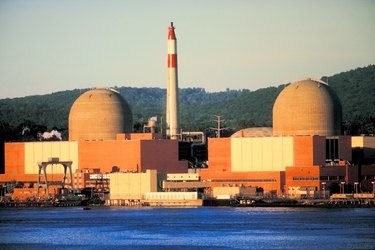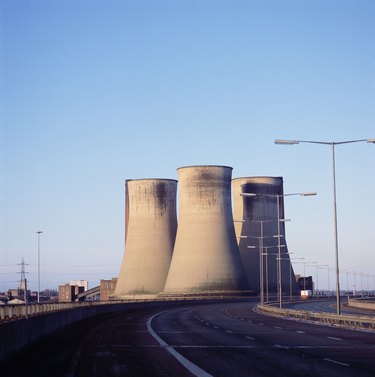
Energy is required to run a large number of things, from homes to cars to electronics. While new energy sources are being sought after at a steady rate, there still remain several more traditional sources of energy. These traditional energy sources are well-established energy sources that are used the world over to make civilization run smoothly.
Coal
Video of the Day

Coal is a non-renewable fossil fuel that supplies electrical power to several power systems across America. Coal is created by fossilized dead plants on the bottom of swamps millions of years ago being heated and pressurized. Coal mines in the United States supply one-fourth of the coal used worldwide. There are three major regions for coal mining within the United States -- the Western, Interior, and Appalachian regions. Most coal from the U.S. comes from the Western region, with Wyoming leading the states for most coal produced. Coal is used as a means for electrical power and making materials such as tar, plastic and steel. Emission-free coal is in development to reduce the amount of pollution produced by burning coal. There is also research in place to find a way to contain the greenhouse gases that are put off by burning coal to keep them from entering the atmosphere.
Video of the Day
Natural Gas

Natural gas is a non-renewable fossil fuel used for a number of different things. Almost one-fourth of the energy used in the United States is natural gas. Natural gas can be used as a heating source in homes, fuel for stoves, and to run hot water heaters and other appliances. This energy source is also used to produce materials such as steel, brick, antifreeze, and explosives. Natural gas is also being looked to as an alternative fuel source for transportation. This fuel source produces fewer harmful emissions than other sources.
Nuclear Energy

Uranium is the main source of nuclear energy, which is non-renewable. To process uranium into nuclear energy, the atoms of uranium must be split to release their energy. Most nuclear energy is produced from the specific uranium type U-235 because of the relative ease of splitting its atoms. The uranium used for power in the United States is mainly imported, particularly from Canada and Australia. Nuclear power is primarily used to provide electricity. When nuclear energy is produced, there is hardly any carbon dioxide produced. However, there is radioactive waste produced, which can be damaging to the environment and a detriment to the health of humans.
Oil

Crude oil, also known as petroleum, is a non-renewable energy source used to produce several different products. Gasoline for transportation is one use for petroleum, used in both personal vehicles and transportation such as jets and semi-trucks. Ink, crayons, tires, ammonia and bubble gum are also products of petroleum. Nearly half of the energy usage in the United States is supplied by oil. Refining petroleum and producing products using petroleum give off several different emissions, such as carbon dioxide, carbon monoxide and sulfur dioxide, which can cause acid rain. Because of this, environmental laws have been put into place to reduce the emissions of oil production and protect the environment.